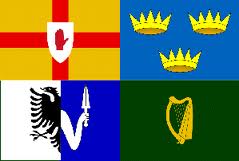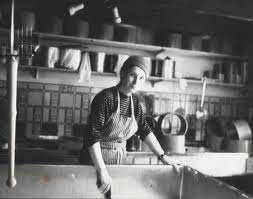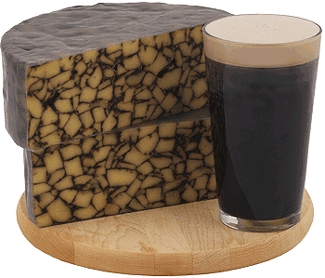The fall & rise of the Irish cheese.
1. Ancient Gaels feast on cheese.
The history of cheesemaking in Ireland, like so many things about the place, is idiosyncratic, not to say baffling. In his unsurpassed study of Irish foodways before the nineteenth century, A. T. Lucas devotes six of thirty-two pages to cheese. Lucas found substantial evidence that “from at least as far back as the Early Christian period down to the close of the 17th century” Ireland produced an array of soft and hard cheeses. These bore variously the Gaelic names faiscre gotha, grus, maethal, maothla, milsen, mulchan, tanach, tanag and others. (Lucas 24, 26) Throughout the period, “cheese of one kind or another formed a standard and substantial part of Irish diet.” (Lucas 24-28, 28)

2. What, no f****ing grus?
Then, for no discernable reason, cheese began to vanish from Ireland. Cathal Cowan and Regina Sexton also date the advent of decline to the seventeenth century but at that point cheese had not yet disappeared entirely. (Cowan 104) Arthur Young, one of the more acute observers ever to write about Ireland, found ‘specialized dairies’ producing cheese during the later 1770s in Cork, Offaly and Wexford. They may have been atypical; Lucas writes that “[d]uring the 18th century the consumption of it progressively declined and the making of it was practiced less and less.” (Lucas 28)
This “extraordinary break in an age-old tradition in food” (Lucas 28) is all the more striking because the production and consumption of butter remained high. Even after the advent of the potato during the eighteenth century, butter and milk, but no longer cheese, remained other staples of the poor.
Lucas cited “international statistics” in 1960 indicating that per capita butter consumption in Ireland “was higher than almost anywhere else in the world.” He does not stop there: “Virtually every kind of source of every age, ancient, medieval and recent, substantiates the evidence for the importance of butter.” (Lucas 30)
According to Darina Allen, Cork boasted the “biggest butter market in the world between 1759 and 1870,” and yet during that period the production and consumption of cheese eroded to the point that by 1802,
“the decline in cheese-making had gone so far that agricultural writers of the time state that little or none was made, while in 1829 it was said; ‘Cheese is not an article of Irish produce; it is brought to the tables of the affluent as an indulgence.’” (Allen 272; Lucas 28)
During his tour of Ireland as a Crown agricultural commissioner investigating the condition of the poor, Jonathan Binns remarked with evident surprise in 1835 that “[t]he making of cheese never enters into the farmer’s contemplation.” (Binns vol. 1, 353) None of these writers, however, offers any explanation why the Irish ceased making and eating cheese.
Cowan and Sexton refer to unidentified “changing economic developments,” which tells us nothing. The argument itself is implausible; cheesemaking did not decline elsewhere, the export market for cheese remained robust, and the same constraints that would have doomed cheesemaking ought to have killed the production of butter.
3. Wartime expedience and anomaly.
The Irish Department of Agriculture and Technical Instruction apparently hired “an experienced manufacturer from England” to develop an industrial ‘Cheddar’ industry beginning in 1907 but this was an apparent anomaly. The cheese must have been awful; production on any scale appears to have been limited to the First World War, when the bulk of it saw export to Britain. (Cowan 100)
Otherwise we know that the vanishing lasted at least until the 1970s. Lucas writes, again in 1960, that cheese remained “an alien thing to the Irish countryman.” (Lucas 28) Today the Irish Food Board notes that “[t]hirty years ago Ireland did not have a living tradition of cheesemaking but only a distant memory.” (bordbia)
4. The return of the (dairy) king.

The Board dates the onset of revival to 1976, when Veronica Steele took her first uncertain steps toward cheesemaking. Her initial attempts were variations on Cheddar. Quality control was variable and she describes some of her early cheeses as “nasty and sour and over salted.” At the suggestion of a friend, Steele switched her experimentation to soft cheese and by 1978 had developed Milleens, “[t]he first, the one and only, Irish Farmhouse Cheese. At last, the real thing after so long.” (milleens)
5. Three Irish cheeses, and stout by any other name.
Steele and her cheese no longer are alone. Irish cheesemakers have proliferated, and judging from the selections that the Editor and staff at britishfoodinamerica have sampled recently, the Irish product is as good as anyone’s. Coolea is a hard cheese made in the mountains of County Cork from cow’s milk, and that is fitting given Cork’s traditional status as a producer and marketing center for milk and butter. It tastes much like a fresher, superior Gouda.
The Ferguson family has been making cheese at its Gubeen farmhouse since 1979. They raise pigs along with their cattle, operate a smokehouse and make charcuterie too. Gubeen is a semisoft, washed rind cheese with uniform little air holes. It has a slight tang and nutty taste that is extremely pleasant.
Now to the guilty pleasure; we like (some) flavored cheeses too, and Ireland produces one of our favorites. A stall at the Eastleigh market outside Southampton used to sell a curried Cheddar that the Editor found irresistible, and even industrially produced cheeses can get by with the appropriate additive. We realize that this confession amounts to apostasy and hope that loyal readers will refrain from boycotting bfia in a rage.
We have enjoyed Scottish cheeses flavored with whisky; it gives them a sweetish tone. The ‘Red Dragon’ that Somerdale makes with ale and mustard seed will not make anyone forget a farmhouse cheese for its texture, but the two flavorings do provide a more balanced palette than the whisky.
The best of the flavored bunch, however, has to be Cahill’s Cheddar with porter; a pint of plain, Flann O’Brien knew, is your only man, and the Cahill product uses Guinness. Cahill’s farm is a big commercial venture in County Limerick, not at all artisanal like the people at Coolea or Gubeen, but the Cheddar has a decent texture and flavor anyway, at least when marbled with porter. They lace their Cheddar with other flavorings too at Cahill, of chive, herbs, Irish whiskey or red wine, but they pale in flavor as well as color to the portered variety.

Apostasy it may be, but Cahill’s with porter is seriously taken; as snooty a spot as Dean & Deluca in New York City sells it at the immodest price of $25 a pound. Take some home and celebrate the revival of a cheesemaking tradition that, in this particular iteration, never really existed before 1986, when Cahill’s began commercial production.
Sources:
Darina Allen, The Complete Book of Irish Country Cooking (New York 1996)
Jonathan Binns, The Miseries and Beauties of Ireland (2 vols; London 1837)
www.bordbia.ie/aboutfood/farmhousecheese
Cathal Cowan & Regina Sexton, Ireland’s Traditional Foods (Dublin 1997)
A. T. Lucas, “Irish Food Before The Potato,” Gwerin vol. III No. 2 (1960) 8-43

